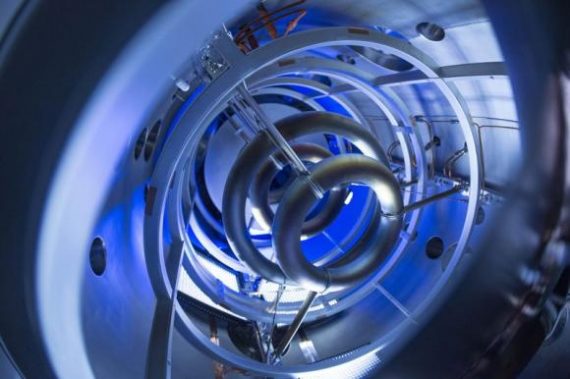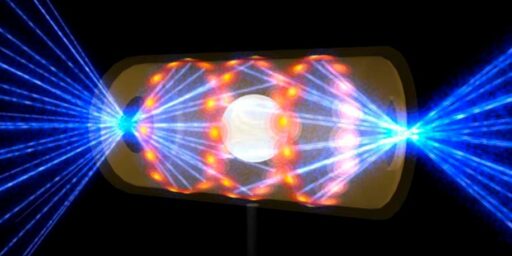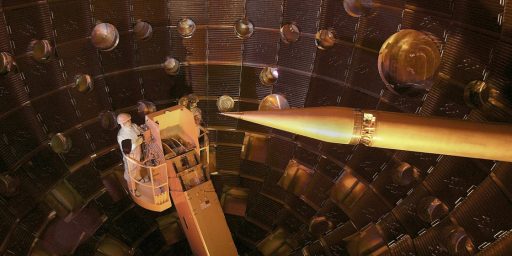Lockheed Martin Says It Made A Breakthrough On Nuclear Fusion
Lockheed Martin says that it has made a promising breakthrough that could lead to the development of reactors based on nuclear fusion, the same process that powers the Sun:
(Reuters) – Lockheed Martin Corp said on Wednesday it had made a technological breakthrough in developing a power source based on nuclear fusion, and the first reactors, small enough to fit on the back of a truck, could be ready for use in a decade.
Tom McGuire, who heads the project, said he and a small team had been working on fusion energy at Lockheed’s secretive Skunk Works for about four years, but were now going public to find potential partners in industry and government for their work.
Initial work demonstrated the feasibility of building a 100-megawatt reactor measuring seven feet by 10 feet, which could fit on the back of a large truck, and is about 10 times smaller than current reactors, McGuire told reporters.
In a statement, the company, the Pentagon’s largest supplier, said it would build and test a compact fusion reactor in less than a year, and build a prototype in five years.
In recent years, Lockheed has gotten increasingly involved in a variety of alternate energy projects, including several ocean energy projects, as it looks to offset a decline in U.S. and European military spending.
Lockheed’s work on fusion energy could help in developing new power sources amid increasing global conflicts over energy, and as projections show there will be a 40 percent to 50 percent increase in energy use over the next generation, McGuire said.
If it proves feasible, Lockheed’s work would mark a key breakthrough in a field that scientists have long eyed as promising, but which has not yet yielded viable power systems. The effort seeks to harness the energy released during nuclear fusion, when atoms combine into more stable forms.
(…)
Compact nuclear fusion would produce far less waste than coal-powered plants since it would use deuterium-tritium fuel, which can generate nearly 10 million times more energy than the same amount of fossil fuels, the company said.
Ultra-dense deuterium, an isotope of hydrogen, is found in the earth’s oceans, and tritium is made from natural lithium deposits.
It said future reactors could use a different fuel and eliminate radioactive waste completely.
McGuire said the company had several patents pending for the work and was looking for partners in academia, industry and among government laboratories to advance the work.
Lockheed said it had shown it could complete a design, build and test it in as little as a year, which should produce an operational reactor in 10 years, McGuire said. A small reactor could power a U.S. Navy warship, and eliminate the need for other fuel sources that pose logistical challenges.
Beyond military applications, of course, this kind of development could have a revolutionary impact on domestic energy production that has been only a dream since the dawn of the Atomic Age. We’ve been here before, of course, most notably with the so-called “Cold Fusion” frenzy in the 1990’s that later proved unworkable, so some degree of healthy skepticism is certainly called for. That being said, one can only hope that this pans out and can be implemented widely because it would prove to be the solution to a wide range of problems facing humanity, and just maybe an end to our dependence on fossil fuels.
Photo via Reuters/Lockheed Martin







This is big and should be breaking news, headlines, and the main talk on all the news shows.
Its implications are enormous. Energy will be clean and much cheaper. It is adaptable to transportation: ships, jets, and motor vehicles. Imagine a car that runs on an unending energy source !
“Fusion is the energy source of the future — and always will be.”
I’ve been following fusion research for a few decades now, and this smells like vaporware. I’m particularly unimpressed by the absence of ANY technical terminology from the story. Was this a tokamak? A stellarator? Inertial containment? Magic beans? Inquiring minds want to know.
LM’s own press release only says that they “take the best of” several magnetic containment approaches. Color me intensely skeptical.
I’m a little suspicious that they are going public to seek out partners. L-M is huge enough and connected enough to find partners without going public.
Color me skeptical. 100 Mw that fits on the back of a truck? Unless the reporter is only referring to the fusion chamber itself this would mean an unbelievable advance in the structures needed to ignite the plasma, contain it and draw energy from it. It would be world changing if true, but why would LM need outside investors? Why would they want to give away a piece of something that would shut down every coal firec plant in the world and solve pollution and climate change, something that would be worth literally trillions of dollars?
This sounds like one of those “we got a crazy scientist in the lab who insists he’s found a way to turn lead into gold, and this is the easiest way to get him to shut up” cases. Or it’s one of those “mmm, maybe you might have something here, but we don’t want to put the money into it.” So they dangle it out there, spin it off as a start-up for other
suckersinvestors to put the necessary capital into, andifwhen it finally works out they’ll come trotting over and take another look-see.Me no investy.
@Tyrell: Dearie, you’d be a godsend to all of those free energy scams that came across my desk in the 90s….
Aviation Leak has more details.
@DrDaveT:
Skeptical is fine. Scoffing not so much. Go over to Schulers place.
@MarkedMan:
Uh, er, maybe internal cash flow is insufficient to fund development? And maybe they need partners who bring certain talents to the party?
@Guarneri: You have a point. Although they have $44B in revenue, they only have $3.4 cash on hand. Still, hard to believe they couldn’t come up with at least $1B a year internally. But even if they did that, they may be looking for a power generating partner to bring expertise.
I’m still skeptical as h*ll though. This is like the 10th fusion “breakthrough” of my life.
I’m skeptical as hell…although L-M buys some credibility.
Certainly it would change the world.
They’re saying ten years out…check back then.
I’m still waiting for flying cars.
@Guarneri:
And you are the authority on where to draw that line?
I’m having a hard time coming up with a way to describe just how implausible it is that the (admittedly very smart) people at LM have solved all of the very very hard problems that dozens of research groups of equally smart people all around the world have been beating their heads against for decades — and simultaneously have scaled it down to about 1/64 the size of the most promising competition out there.
It’s the credibility equivalent of claiming to have discovered a new antibiotic that kills every nasty strain out there, but has no bad side effects. Is that possible? Absolutely. Is it likely? No.
Thanks,
grumpy realist, for the link. That tells me a lot more about what they are doing and where they think they are in the process.They think they are five years away from a working prototype, minimum. If they succeed, no one will be happier than I am, nor more ready to give them credit for what really would be an astonishing leap ahead.
i got five bucks on Lockheed. Call me an optimist – also, they have credibility and wouldn’t go to press on the basis of nothing.
Tyrell’s right, this should be news – it’s closer to genuine news than the 24/7 Ebola Scare-a-Thon. If this is real, the world changes.
We’ve been here before, of course, most notably with the so-called “energy so cheap that we won’t meter it” frenzy in the 1950’s
I’ll believe this when they demonstrate this on tv. Otherwise, no sale.
Do they have a warp drive in development too?
To get it to work all they will need is the Illudium Pu-36 Explosive Space Modulator.
I’ll believe this when I see it in the back of a DeLorean.
@DrDaveT: This reminds me of the old adage I heard in grad school: we’re always just five years away for silicon to be replaced by gallium arsenide.
@grumpy realist:
I looked that up and trying to read the Wikipedia Article gave me a headache.
@jd: I expect to have one in the back of my flying car.
@michael reynolds:
Looking back, it seems that this isn’t the first time they’ve gone to press with this. They announced this project at least 18 months ago. They have a design, and are working to engineer it. 18 months ago, it was five years away. Today, it’s five years away.
Here’s my problem with the claims: cylindrical containment (“mirror machine”) has been around for a long time. If it were really as stable as the linked article above seems to claim, then nobody would be futzing around with tokamaks or stellarators or spherical fields or z-pinch machines any more, because none of them are stable and that’s a huge problem. They all exhibit positive feedback when the plasma gets out of symmetry, and require amazingly complicated real-time control to keep tiny fluctuations from turning into containment failure a few seconds later. ITER is making the internal walls of its plasma chamber out of liquid-cooled beryllium-coated tungsten, so that it can withstand the inevitable scorches.
Either the LM guys are missing something that everyone else knows, or everyone else is missing something that the LM guys have figured out. I await the inevitable article in Science that will explain which it was….
I don’t have the technical chops to even begin to try and understand what the claim is here, but I am skeptical. Fusion power has long been a dream.
But if they can pull it off, it would be an incredible game-changer. It would make a transition to an ultra-low carbon economy much, much easier. For that reason alone, I’m rooting hard for LM.